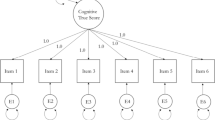Abstract
A method of Guttman scalogram analysis is presented that does not involve sorting and rearranging the entries in the item response matrix. The method requires dichotomous items. Formulas are presented for estimating the reproducibility of the scale and estimating the expected value of the chance reproducibility. An index of consistency is suggested for evaluating the reproducibility. An illustrative example is presented in detail. The logical basis of the method is discussed. Finally, several methods are suggested for dealing with non-dichotomous items.
Similar content being viewed by others
References
Festinger, L. The treatment of qualitative data by “scale analysis.”Psychol. Bull., 1947,44, 146–161.
Ford, R. N. A rapid scoring procedure for scaling attitude questions.Publ. Opin. Quart., 1950,14, 507–532.
Guttman, L. The Cornell technique for scale and intensity analysis.Educ. psychol. Measmt., 1947,7, 247–279.
Guttman, L. The basis for scalogram analysis. In S. A. Stoufferet al.: Measurement and prediction. Princeton, N. J.: Princeton Univ. Press, 1950. Pp. 60–90.
Jackson, J. M. A simple and more rigorous technique for scale analysis. In: A manual of scale analysis, Part II. Montreal: McGill Univ., Mimeo, 1949.
Kahn, L. H. and Bodine, A. J. Guttman scale analysis by means of IBM equipment.Educ. psychol. Measmt., 1951,11, 298–314.
Loevinger, Jane. A systematic approach to the construction and evaluation of tests of ability.Psychol. Monogr., 1947,61, No. 4.
Marder, E. Linear segments: a technique for scalogram analysis.Publ. Opin. Quart., 1952,16, 417–431.
Menzel, H. A new coefficient for scalogram analysis.Publ. Opin. Quart., 1953,17, 268–280.
Noland, E. W. Worker attitude and industrial absenteeism: a statistical appraisal.Amer. sociol. Rev., 1945,10, 503–510.
Stouffer, S. A., Borgatta, E. F., Hays, D. G., and Henry, A. F. A technique for improving cumulative scales.Publ. Opin. Quart., 1952,16, 273–291.
Suchman, E. A. The scalogram board technique for scale analysis. In S. A. Stoufferet al.: Measurement and prediction. Princeton, N. J.: Princeton Univ. Press, 1950, Pp. 91–121.
Suchman, E. A. The utility of scalogram analysis. In S. A. Stoufferet al.: Measurement and prediction. Princeton, N. J.: Princeton Univ. Press, 1950, Pp. 122–171.
Author information
Authors and Affiliations
Additional information
Lois K. Anderson assisted the author materially in the many computations required for this paper. The research reported in this paper was supported in part by the Department of Economics and Social Sciences at M.I.T. and in part, jointly, by the Army, Navy and Air Force under contract with the Massachusetts Institute of Technology.
Rights and permissions
About this article
Cite this article
Green, B.F. A method of scalogram analysis using summary statistics. Psychometrika 21, 79–88 (1956). https://doi.org/10.1007/BF02289088
Received:
Revised:
Issue Date:
DOI: https://doi.org/10.1007/BF02289088




